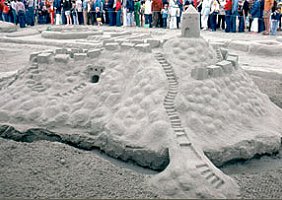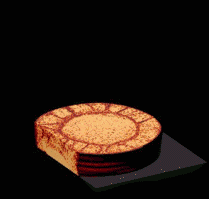|
An upcoming shuttle mission will carry small
columns of sand into space - and will return with valuable lessons
for earthquake engineers, scientists, farmers and physicists.
by Patrick L Barry
Give a plastic bucket and a shovel to
a child, then turn her loose on a beach full of sand. She'll happily
toil the day away building the sandcastle to end all sandcastles.
It's pure fun.
It's also serious physics.
Sandcastles are built from grains -billions of tiny
sharp-edged particles that rub and tumble together. The strength
of a sandcastle depends on how the grains interact. What happens
when they're wet? How do they respond to a jolt? It's not only beachgoers
who are interested; farmers, physicists and engineers want to know,
too.
When kids work on a sandcastle, they begin by gathering
water from the ocean to wet the sand. Not too much-just enough
to make sand stick together without oozing. (Emergency planners:
think of predicting a devastating mudslide.) Next they pack the
damp sand into a bucket, and flip it over to create an extra-strong
base for a tower (Engineers: think of designing compacted road foundations.)
Kids love to build the towers
taller and taller-until a wall suddenly caves and the tower slides
into the moat. (Farmers: think of grain in a silo sticking together,
then suddenly collapsing and destroying the silo.) They might even
decorate the castle by letting watery sand drip from their fingertips,
solidifying in place to form odd-looking stalagmites. (Artists:
don't forget, physics is beautiful.)

Photo by George Vetter, for "Cannon Beach Sand Castle Contest,"
an Oregon Local Legacies project
A Sand
Fortress - July 1980
|
Scientists mostly understand why sand
on a beach behaves as it does. Damp sand sticks together because
water forms little grain-to-grain bridges. Surface tension - the
same force that lets some insects walk on the surface of a pond,
acts like rubber bands between the grains. Adding water to damp
sand fills spaces between the grains. The bridges vanish and the
sand begins to flow more easily.
Sounds simple, but wet sand can still
puzzle researchers.
For example, when an earthquake strikes,
wet soil underground sometimes "liquefies". Suddenly becoming more
like quicksand than the sturdy walls of a sandcastle. This happened
during the 1989 Loma Prieta earthquake in San Francisco. Vibrations
liquefied water-soaked soil in the Marina District, causing buildings
to sink until their third floors were at ground level.
This transition is rapid and poorly
understood.
During an earthquake, shockwave's compress
the soil faster than water can escape, raising the pressure of the
water. As the water pressure increases, the water bears more and
more of the load; the sand bears less and less. Ironically, this
sudden compression reduces the pressure between individual
sand grains-sometimes even beneath tons of rock and dirt.
"That much is understood," says Stein
Sture, a professor of engineering at the University of Colorado-Boulder,
"But how exactly do the grains interact as the pressures between
them approach zero?"
"Studying this process in ground-based
laboratories is difficult because the sand's own weight creates
stress on the grains," he continued. If experimenters could remove
that stress (and do so for a long time), they could more easily
probe soil liquefaction .
That's why Sture is sending sand to
space. He's the lead investigator for an experiment called Mechanics
of Granular Materials-III-"MGM-III" for short-slated to fly onboard
space shuttle Columbia (STS-107) later this year.

more
An automobile
lies crushed under the third story of this San Francisco
apartment building after the 1989 Loma Prieta Earthquake
|
The experiment is deceptively simple:
A column of water-saturated sand in a latex sleeve is repeatedly
squeezed between two plates. (In sandcastle terms, the consistency
of the sand is more like the watery sand dripping from your fingers
than the damp sand packed to make a strong tower base.) A full cycle
of "squeeze and release" takes about ten minutes. This compression
mimics what happens to water-filled soil during an earthquake.
Three cameras on the space shuttle
will document how the column deforms. After the experiment is returned
to Earth, scientists will use Computed Tomography scans (CT scans)
to study the internal structure of the sand column. Then they will
inject epoxy to harden the sand, preserving internal patterns for
further analysis under the microscope.
"This will be the first time that we've
had a window into this important process," Sture says.
Earlier flights of the MGM device onboard shuttles
Atlantis (STS-79) and Endeavour (STS-89) revealed surprising things
about dry sand. Lacking real data for low-pressure soils, scientists
had assumed that trends seen at higher pressures would simply continue
to lower pressures as well. But MGM-I and II showed otherwise.

more
Computed
Tomography scans (CT scans) of the sand column after it's
returned to Earth reveal important clues about the behaviour
of the sand under compression.
|
"We found, for example, strength properties that
are nearly twice what we would have normally thought," says Sture, which
means that at low pressures a layer of sand can support twice as
much weight as previously thought possible. Yet if you reduce the
pressure a little more so that it approaches zero, that strength
evaporates completely. Puzzling!
Maybe similar surprises await MGM-III. No one knows.
Sture notes that "understanding this soil liquefaction
process will help engineers decide when a site is safe for construction,
and perhaps lead to designs for building foundations that help prevent
liquefaction from occurring."
The practical benefits of these experiments will reach beyond soils.
Grain in a silo is also a granular material, as are bulk cereals,
many fertilizers, and coal and ash. In all these cases, knowing
how to coax the material into smoothly flowing or staying in place
would be a good thing.
It's something to ponder the next time you're building a sandcastle:
inside the moat lies some far-reaching physics.
|
